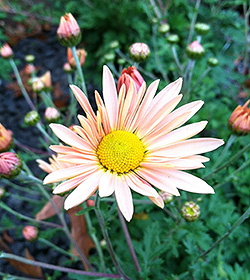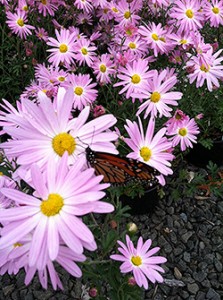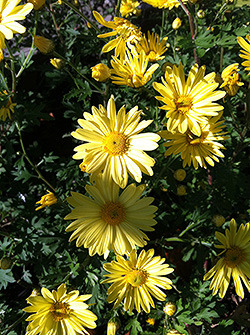Mum’s The Word
Posted in Horticulture on October 21 2014, by Sonia Uyterhoeven
Sonia Uyterhoeven is NYBG‘s Gardener for Public Education.

We are heading into the final weekend of Kiku: The Art of the Japanese Garden. The show is awash with vivid autumnal color and exotic chrysanthemum blooms in every shape and size imaginable.
For those curious, there are 13 different classes of chrysanthemums. Some of my favorites are the Edo varieties which fall into the last class of mums—Class 13: Unclassified or Exotic. These are the chrysanthemum flower shapes that do not fit into any established category. They often have twisted, bi-color florets that change their shape as they open.
Beyond these, there are many fun and fanciful chrysanthemum flower forms to cover. Chrysanthemums from the Brush and Thistle class look like an artist’s paint brush. Spider mums look like fireworks exploding in the sky. They have long, tubular ray florets that hook or coil at the end. Anemone-type mums have centers that are raised up like a pincushion, and chrysanthemums from the Spoon class have long ray florets with tips that are shaped as their name suggests.

The exhibition mums take from 9–12 months to grow. They are fed, pinched, and laboriously trained into ornate shapes. The showiest display is Ozukuri or “Thousand Bloom.” From one small cutting, the mum is trained into five main branches that are repeatedly pinched to form an intricate framework of flowers. Kengai or “Cascade” is trained in a fishbone pattern to cover a large panel. After 10 months, the frame is tilted downwards to form a flowing cascade.
While the exhibition mums are fragile and require an enormous amount of care, homeowners can have their fall chrysanthemum color without all the hassle. Granted, they will not be trained to perfection or come in all the exotic flower forms mentioned here—unless that happens to be your expertise!
Belgian mums are readily available on the market these days for the casual mum gardener. They are hardy provided they are planted in September and given enough time to establish a solid root system. These mums are no-pinch and are flexible enough that they do not break easily. Varieties of these mums are categorized by flowering time: very early, early, mid, and late. You can extend your flowering season from early September until early November by selecting mums from different flowering categories.
This year in the Garden we have planted one of my favorite mums, Chrysanthemum rubellum ‘Sheffield Pink’. It is another hardy chrysanthemum that looks more like Korean mums than the ubiquitous florist or Belgian mums. These mums reach 2–3 feet tall and spread to form an open, loose clump. They often require staking and it is a good idea to pinch these mums back once or twice earlier in the season (late May into June), or to cut them back by half in early June.

This year in our container displays we have ‘Sheffield’, ‘Sheffield Pink’, and ‘Sheffield Yellow’ planted. ‘Sheffield’ opens up apricot and takes on pink overtones as it matures; ‘Sheffield Pink’ is a baby pink that has a small white halo around its yellow eye; and ‘Sheffield Yellow’ is a cheerful yellow with apricot and gold buds.
Mums like full sun to partial shade. They thrive in rich, well-drained soil. Add compost or organic matter when you plant. If you are pinching your mums, it is best to pinch before July 4th, otherwise they will flower too late in the season. Wait until spring to cut back your mums or at least leave several inches for winter protection and lightly mulch around them if they are planted in an exposed site.


Hi Sonia:
We picked up two pretty plants at the garden center a few weeks ago. I assume they are hardy (not sure) is there a way to tell? Our neighbor suggested that we bring them in.
How late can they stay out? Know you are busy so no rush to answer my question. I love your articles and writing style.
My favorite at the show this year is the yellow spoon.
Thanks and best,
Barbara